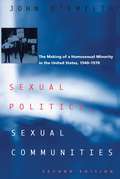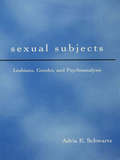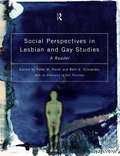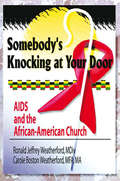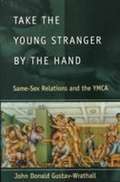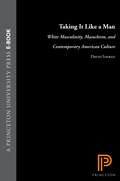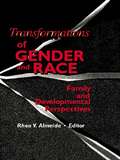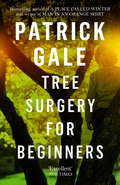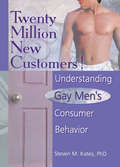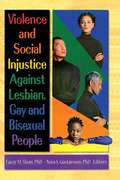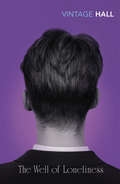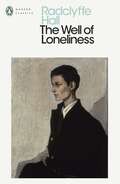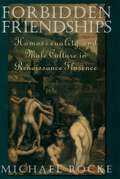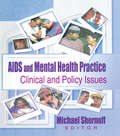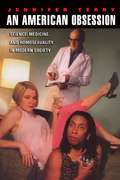- Table View
- List View
Sexual Politics, Sexual Communities: Second Edition
by John D'EmilioWith thorough documentation of the oppression of homosexuals and biographical sketches of the lesbian and gay heroes who helped the contemporary gay culture to emerge, Sexual Politics, Sexual Communities supplies the definitive analysis of the homophile movement in the U.S. from 1940 to 1970. John D'Emilio's new preface and afterword examine the conditions that shaped the book and the growth of gay and lesbian historical literature. "How many students of American political culture know that during the McCarthy era more people lost their jobs for being alleged homosexuals than for being Communists? . . . These facts are part of the heretofore obscure history of homosexuality in America—a history that John D'Emilio thoroughly documents in this important book."—George DeStefano, Nation "John D'Emilio provides homosexual political struggles with something that every movement requires—a sympathetic history rendered in a dispassionate voice."—New York Times Book Review "A milestone in the history of the American gay movement."—Rudy Kikel, Boston Globe
Sexual Subjects: Lesbians, Gender and Psychoanalysis
by Adria E. SchwartzSexual Subjects, a psychoanalytic book informed by gender theory, queer theory and feminism, addresses the tensions inherent in writing about lesbians and sexuality in the postmodern age. Adria Schwartz masterfully intertwines clinical anecdotes with engaging theoretical questions that examine the construction of important categories of identity--woman, feminist, mother, lesbian, and homo/hetero/bisexual. Schwartz also addresses specific issues which are problematic but nonetheless meaningful to self-identified lesbians such as roles in gender play, lesbian "bed death," and raising non-traditional families. Written from a psychoanalytic and postmodern perspective, this book is a significant contribution to the work done on the conceptualization of lesbian sexuality and identity.
Sexual Subjects: Lesbians, Gender and Psychoanalysis
by Adria E. SchwartzSexual Subjects, a psychoanalytic book informed by gender theory, queer theory and feminism, addresses the tensions inherent in writing about lesbians and sexuality in the postmodern age. Adria Schwartz masterfully intertwines clinical anecdotes with engaging theoretical questions that examine the construction of important categories of identity--woman, feminist, mother, lesbian, and homo/hetero/bisexual. Schwartz also addresses specific issues which are problematic but nonetheless meaningful to self-identified lesbians such as roles in gender play, lesbian "bed death," and raising non-traditional families. Written from a psychoanalytic and postmodern perspective, this book is a significant contribution to the work done on the conceptualization of lesbian sexuality and identity.
SOCIAL PERSPECTIVES IN LESBIAN AND GAY STUDIES
by Peter M. Nardi Beth E. SchneiderThis comprehensive reader brings a social science perspective to an area hitherto dominated by the humanities. Through it, students will be able to follow the story of how sociology has come to engage with gay and lesbian issues from the 1950s to the present, from the earliest research on the underground worlds of gay men to the emergence of queer theory in the 1990s.
SOCIAL PERSPECTIVES IN LESBIAN AND GAY STUDIES (PDF)
by Peter M. Nardi Beth E. SchneiderThis comprehensive reader brings a social science perspective to an area hitherto dominated by the humanities. Through it, students will be able to follow the story of how sociology has come to engage with gay and lesbian issues from the 1950s to the present, from the earliest research on the underground worlds of gay men to the emergence of queer theory in the 1990s.
Somebody's Knocking at Your Door: AIDS and the African-American Church
by Harold G Koenig Carole B Weatherford Ronald J WeatherfordExamining the black church’s response to AIDS, Somebody’s Knocking at Your Door: AIDS and the African-American Church analyzes sexual ethics and homophobia in the black church to provide pastors, social workers, and health professionals with intervention strategies for parishioners or members of the community who have AIDS. By discussing the church’s historic and successful activism and its relationship to the community, along with AIDS statistics, relevant theologies, and other AIDS ministries, this book suggests the benefits of increased church involvement versus other agencies or organizations. Somebody’s Knocking at Your Door will help you develop prevention education and pastoral care programs that will alert individuals to the risks of AIDS and will offer people with AIDS the comfort and assistance they need in coping with the disease.Through the voices of leading clergy, AIDS advocates, and people living with AIDS (PLWAs), this book calls on the African-American church to become more involved in helping communities deal with the disease. Somebody’s Knocking at Your Door offers you ideas on how to improve the lives of individuals with AIDS through the church, including: welcoming PLWAs into the church through announcements by local media, church newsletters, and Sunday bulletins offering AIDS support groups at the church or loaning office space, equipment, or clerical assistance to AIDS organizations recognizing the power of intercessory prayer for PLWAs caring for PLWAs by delivering meals to their homes, preparing meals at the church, and developing a transportation network that will take parishioners to doctor appointments, church, or on recreational outings preparing meals, running errands, housekeeping, handling paperwork, negotiating legal issues, and offering friendship-- possible components of volunteer “buddy programs” for homebound PLWAs training pastors, clergy, and Sunday school teachers to educate ministries on AIDS in the African- American community, sexual intimacy, intravenous drug use and needle sharing, monogamy, community resources, and condom useSince some clergy still believe that AIDS is a “gay” disease, Somebody’s Knocking at Your Door discusses the issue of homosexuality within the church. By analyzing passages from the Bible, the authors refute the belief that homosexuals were neglected by God and undeserving of care and love. This belief, according to the authors, inhibits some churches and individuals from discussing HIV/AIDS because of fear they would also be acknowledging homosexuality. Highlighting AIDS ministries throughout the United States, Somebody’s Knocking at Your Door encourages the African-American church to confront the issue of AIDS and understand that the disease can affect anyone. This book will give you the necessary strategies for starting and implementing AIDS ministries and intervention programs that will educate and support your community.
Somebody's Knocking at Your Door: AIDS and the African-American Church
by Harold G Koenig Carole B Weatherford Ronald J WeatherfordExamining the black church’s response to AIDS, Somebody’s Knocking at Your Door: AIDS and the African-American Church analyzes sexual ethics and homophobia in the black church to provide pastors, social workers, and health professionals with intervention strategies for parishioners or members of the community who have AIDS. By discussing the church’s historic and successful activism and its relationship to the community, along with AIDS statistics, relevant theologies, and other AIDS ministries, this book suggests the benefits of increased church involvement versus other agencies or organizations. Somebody’s Knocking at Your Door will help you develop prevention education and pastoral care programs that will alert individuals to the risks of AIDS and will offer people with AIDS the comfort and assistance they need in coping with the disease.Through the voices of leading clergy, AIDS advocates, and people living with AIDS (PLWAs), this book calls on the African-American church to become more involved in helping communities deal with the disease. Somebody’s Knocking at Your Door offers you ideas on how to improve the lives of individuals with AIDS through the church, including: welcoming PLWAs into the church through announcements by local media, church newsletters, and Sunday bulletins offering AIDS support groups at the church or loaning office space, equipment, or clerical assistance to AIDS organizations recognizing the power of intercessory prayer for PLWAs caring for PLWAs by delivering meals to their homes, preparing meals at the church, and developing a transportation network that will take parishioners to doctor appointments, church, or on recreational outings preparing meals, running errands, housekeeping, handling paperwork, negotiating legal issues, and offering friendship-- possible components of volunteer “buddy programs” for homebound PLWAs training pastors, clergy, and Sunday school teachers to educate ministries on AIDS in the African- American community, sexual intimacy, intravenous drug use and needle sharing, monogamy, community resources, and condom useSince some clergy still believe that AIDS is a “gay” disease, Somebody’s Knocking at Your Door discusses the issue of homosexuality within the church. By analyzing passages from the Bible, the authors refute the belief that homosexuals were neglected by God and undeserving of care and love. This belief, according to the authors, inhibits some churches and individuals from discussing HIV/AIDS because of fear they would also be acknowledging homosexuality. Highlighting AIDS ministries throughout the United States, Somebody’s Knocking at Your Door encourages the African-American church to confront the issue of AIDS and understand that the disease can affect anyone. This book will give you the necessary strategies for starting and implementing AIDS ministries and intervention programs that will educate and support your community.
Take the Young Stranger by the Hand: Same-Sex Relations and the YMCA (Chicago Series on Sexuality, History, and Society)
by John Donald Gustav-WrathallNow associated with family health clubs, the YMCA's bland image is the result of relentless outreach and the studied avoidance of controversy. But, as John Gustav-Wrathall shows in his revealing social history of the organization, the life of the YMCA has been filled with strife, tragedy, and irony, a life that itself reflects the struggle over the shifting societal mores regarding masculine friendship and intimacy. Take the Young Stranger by the Hand presents the YMCA as an institution of profound contradictions, reflective of society's views of same-sex love and sexuality. "Gustav-Wrathall's book offers an in-depth history of the origins and purposes of the Young Men's Christian Association and how it evolved into—and out of—a gay playland."—Arnie Kantrowitz, Lambda Book Report "The book's absorbing exploration of the sometimes schismatic, sometimes synergistic relationship between spirituality and sexuality is a fascinating addition to the growing body of social history."—Jim Van Buskirk, San Francisco Bay Guardian
Taking It Like a Man: White Masculinity, Masochism, and Contemporary American Culture
by David SavranFrom the Beat poets' incarnation of the "white Negro" through Iron John and the Men's Movement to the paranoid masculinity of Timothy McVeigh, white men in this country have increasingly imagined themselves as victims. In Taking It Like a Man, David Savran explores the social and sexual tensions that have helped to produce this phenomenon. Beginning with the 1940s, when many white, middle-class men moved into a rule-bound, corporate culture, Savran sifts through literary, cinematic, and journalistic examples that construct the white man as victimized, feminized, internally divided, and self-destructive. Savran considers how this widely perceived loss of male power has played itself out on both psychoanalytical and political levels as he draws upon various concepts of masochism--the most counterintuitive of the so-called perversions and the one most insistently associated with femininity.Savran begins with the writings and self-mythologization of Beat writers William Burroughs, Allen Ginsberg, and Jack Kerouac. Although their independent, law-defying lifestyles seemed distinctively and ruggedly masculine, their literary art and personal relations with other men in fact allowed them to take up social and psychic positions associated with women and racial minorities. Arguing that this dissident masculinity has become increasingly central to U.S. culture, Savran analyzes the success of Sam Shepard as both writer and star, as well as the emergence of a new kind of action hero in movies like Rambo and Twister. He contends that with the limited success of the civil rights and women's movements, white masculinity has been reconfigured to reflect the fantasy that the white male has become the victim of the scant progress made by African Americans and women.Taking It Like a Man provocatively applies psychoanalysis to history. The willingness to inflict pain upon the self, for example, serves as a measure of men's attempts to take control of their situations and their ambiguous relationship to women. Discussing S/M and sexual liberation in their historical contexts enables Savran to consider not only the psychological function of masochism but also the broader issues of political and social power as experienced by both men and women.
Taking It Like a Man: White Masculinity, Masochism, and Contemporary American Culture
by David SavranFrom the Beat poets' incarnation of the "white Negro" through Iron John and the Men's Movement to the paranoid masculinity of Timothy McVeigh, white men in this country have increasingly imagined themselves as victims. In Taking It Like a Man, David Savran explores the social and sexual tensions that have helped to produce this phenomenon. Beginning with the 1940s, when many white, middle-class men moved into a rule-bound, corporate culture, Savran sifts through literary, cinematic, and journalistic examples that construct the white man as victimized, feminized, internally divided, and self-destructive. Savran considers how this widely perceived loss of male power has played itself out on both psychoanalytical and political levels as he draws upon various concepts of masochism--the most counterintuitive of the so-called perversions and the one most insistently associated with femininity.Savran begins with the writings and self-mythologization of Beat writers William Burroughs, Allen Ginsberg, and Jack Kerouac. Although their independent, law-defying lifestyles seemed distinctively and ruggedly masculine, their literary art and personal relations with other men in fact allowed them to take up social and psychic positions associated with women and racial minorities. Arguing that this dissident masculinity has become increasingly central to U.S. culture, Savran analyzes the success of Sam Shepard as both writer and star, as well as the emergence of a new kind of action hero in movies like Rambo and Twister. He contends that with the limited success of the civil rights and women's movements, white masculinity has been reconfigured to reflect the fantasy that the white male has become the victim of the scant progress made by African Americans and women.Taking It Like a Man provocatively applies psychoanalysis to history. The willingness to inflict pain upon the self, for example, serves as a measure of men's attempts to take control of their situations and their ambiguous relationship to women. Discussing S/M and sexual liberation in their historical contexts enables Savran to consider not only the psychological function of masochism but also the broader issues of political and social power as experienced by both men and women.
Taking It Like a Man: White Masculinity, Masochism, and Contemporary American Culture
by David SavranFrom the Beat poets' incarnation of the "white Negro" through Iron John and the Men's Movement to the paranoid masculinity of Timothy McVeigh, white men in this country have increasingly imagined themselves as victims. In Taking It Like a Man, David Savran explores the social and sexual tensions that have helped to produce this phenomenon. Beginning with the 1940s, when many white, middle-class men moved into a rule-bound, corporate culture, Savran sifts through literary, cinematic, and journalistic examples that construct the white man as victimized, feminized, internally divided, and self-destructive. Savran considers how this widely perceived loss of male power has played itself out on both psychoanalytical and political levels as he draws upon various concepts of masochism--the most counterintuitive of the so-called perversions and the one most insistently associated with femininity.Savran begins with the writings and self-mythologization of Beat writers William Burroughs, Allen Ginsberg, and Jack Kerouac. Although their independent, law-defying lifestyles seemed distinctively and ruggedly masculine, their literary art and personal relations with other men in fact allowed them to take up social and psychic positions associated with women and racial minorities. Arguing that this dissident masculinity has become increasingly central to U.S. culture, Savran analyzes the success of Sam Shepard as both writer and star, as well as the emergence of a new kind of action hero in movies like Rambo and Twister. He contends that with the limited success of the civil rights and women's movements, white masculinity has been reconfigured to reflect the fantasy that the white male has become the victim of the scant progress made by African Americans and women.Taking It Like a Man provocatively applies psychoanalysis to history. The willingness to inflict pain upon the self, for example, serves as a measure of men's attempts to take control of their situations and their ambiguous relationship to women. Discussing S/M and sexual liberation in their historical contexts enables Savran to consider not only the psychological function of masochism but also the broader issues of political and social power as experienced by both men and women.
Transformations of Gender and Race: Family and Developmental Perspectives
by Rhea AlmeidaTransformations of Gender and Race will help you become a better therapist by arming you with new theories and practices that concern inclusiveness of identity, psyche, and culture in the therapy room. This book radically shifts current thinking in systemic theory and practice with individuals, children, couples, and families, giving you a fresh perspective on working with your clients of all cultural backgrounds and both genders.In Transformations of Gender and Race: Family and Developmental Perspectives, you’ll discover superb contemporary thinking in cultural studies, post-colonial theory, gender theory, queer theory, and clinical and research work with numerous populations who have been overlooked and undertheorized. You’ll gain a wealth of knowledge and expertise from its contributors who have been immersed in the issues they address.The chapters in Transformations of Gender and Race provide a superb, state-of-the-art bibliography of contemporary thinking in cultural studies, post-colonial theory, and clinical and research work with numerous populations who have been “overlooked and undertheorized.” The new paradigms dicussed and practiced in Transformations in Gender and Race encourage cultural multiplicity, inclusiveness, and understanding. A pallete of contemporary thinking, this insightful book will guide you in: how to bring diversity into the lived experience of young children numerous theoretical paradigms couples therapy men&’s work and children addressing the intersections of gender, race, class, and culture in the therapy room transformations regarding race and gender the inclusiveness of feminismA wealth of expertise and sharp observation that reaches out to enrich and humanize therapy practices, Transformations of Gender and Race addresses the interactions between gender, class, race, sexual orientation, and age. Creative and in-depth, this volume articulates a perspective that connects all of these contexts of potential oppression and privilege. You will gain a deeper understanding of numerous theoretical paradigms for working with couples, individuals, and children that will improve your practice.
Transformations of Gender and Race: Family and Developmental Perspectives
by Rhea AlmeidaTransformations of Gender and Race will help you become a better therapist by arming you with new theories and practices that concern inclusiveness of identity, psyche, and culture in the therapy room. This book radically shifts current thinking in systemic theory and practice with individuals, children, couples, and families, giving you a fresh perspective on working with your clients of all cultural backgrounds and both genders.In Transformations of Gender and Race: Family and Developmental Perspectives, you’ll discover superb contemporary thinking in cultural studies, post-colonial theory, gender theory, queer theory, and clinical and research work with numerous populations who have been overlooked and undertheorized. You’ll gain a wealth of knowledge and expertise from its contributors who have been immersed in the issues they address.The chapters in Transformations of Gender and Race provide a superb, state-of-the-art bibliography of contemporary thinking in cultural studies, post-colonial theory, and clinical and research work with numerous populations who have been “overlooked and undertheorized.” The new paradigms dicussed and practiced in Transformations in Gender and Race encourage cultural multiplicity, inclusiveness, and understanding. A pallete of contemporary thinking, this insightful book will guide you in: how to bring diversity into the lived experience of young children numerous theoretical paradigms couples therapy men&’s work and children addressing the intersections of gender, race, class, and culture in the therapy room transformations regarding race and gender the inclusiveness of feminismA wealth of expertise and sharp observation that reaches out to enrich and humanize therapy practices, Transformations of Gender and Race addresses the interactions between gender, class, race, sexual orientation, and age. Creative and in-depth, this volume articulates a perspective that connects all of these contexts of potential oppression and privilege. You will gain a deeper understanding of numerous theoretical paradigms for working with couples, individuals, and children that will improve your practice.
Tree Surgery for Beginners: A Novel
by Patrick GaleFrom the bestselling author of A PLACE CALLED WINTER, TREE SURGERY FOR BEGINNERS is a funny, elegant and eclectic novel of love, lies and the secrets we live with 'A very funny, often sad, erudite eclectic novel writ with style. Terrific' Time Out'Excellent' The TimesWhen Lawrence Frost wakes up one morning to discover his wife and child have gone missing, there is gruesome evidence to suggest he may be the main suspect in a murder investigation. Confused, threatened with the loss of everything he loves, Lawrence is sent to the Caribbean on a kill-or-cure cruise. On board and ashore he will discover love, deceit, the truth about his missing family, and the blessings that come with surrendering to destiny.
Twenty Million New Customers!: Understanding Gay Men's Consumer Behavior
by Steven M KatesMost of the world’s population is in the dark when it comes to the consumer patterns of gay men. But in Twenty Million New Customers!: Understanding Gay Men’s Consumer Behavior, you’ll leave all the dark, homophobic myths behind where they belong--in the closet--and come out into the light. In its colorful and informative chapters, you’ll see why gay men are a vital consumer lifeline to today’s clothing industries as you tap into revealing psychological characteristics that will benefit any business manager. A scholarly yet personal, poignant study, Twenty Million New Customers! is a mixed shopping bag, taking you on a day-in-the-life tour of the buying patterns of 44 gay men. As an up-to-date catalog of scholarly data, it helps you see how “mainstream” businesses can tailor their marketing methods to this rapidly expanding demand in a competent, professional, and ethical manner. As a commentary on lifestyle, it transports you to unexplored consumer behavior territory that most people still consider “deviant.” Specifically, you’ll read about: in-depth, personal interviews from gay consumers real-life problems and market needs of gay men consumer behavior as political protest self-concept, identity, community, and culture the creation and maintenance of gay consumer subculture research methods and managerial implications of the studyA recent survey estimates that over six percent of U.S. consumers openly acknowledges themselves as gay--clearly a priceless niche. So if you’re a gay man trying to get the skinny on the latest bodysuit trends, a marketing scholar involved in quantitative methods research, or a manager interested in retiring your old, outdated business savvy to the closet and exchanging it for a flashy, new, informed sense of marketing pizzazz, read Twenty Million New Customers! It’ll shut the closet on the harmful myths surrounding gay consumerism and open the door to success.
Twenty Million New Customers!: Understanding Gay Men's Consumer Behavior
by Steven M KatesMost of the world’s population is in the dark when it comes to the consumer patterns of gay men. But in Twenty Million New Customers!: Understanding Gay Men’s Consumer Behavior, you’ll leave all the dark, homophobic myths behind where they belong--in the closet--and come out into the light. In its colorful and informative chapters, you’ll see why gay men are a vital consumer lifeline to today’s clothing industries as you tap into revealing psychological characteristics that will benefit any business manager. A scholarly yet personal, poignant study, Twenty Million New Customers! is a mixed shopping bag, taking you on a day-in-the-life tour of the buying patterns of 44 gay men. As an up-to-date catalog of scholarly data, it helps you see how “mainstream” businesses can tailor their marketing methods to this rapidly expanding demand in a competent, professional, and ethical manner. As a commentary on lifestyle, it transports you to unexplored consumer behavior territory that most people still consider “deviant.” Specifically, you’ll read about: in-depth, personal interviews from gay consumers real-life problems and market needs of gay men consumer behavior as political protest self-concept, identity, community, and culture the creation and maintenance of gay consumer subculture research methods and managerial implications of the studyA recent survey estimates that over six percent of U.S. consumers openly acknowledges themselves as gay--clearly a priceless niche. So if you’re a gay man trying to get the skinny on the latest bodysuit trends, a marketing scholar involved in quantitative methods research, or a manager interested in retiring your old, outdated business savvy to the closet and exchanging it for a flashy, new, informed sense of marketing pizzazz, read Twenty Million New Customers! It’ll shut the closet on the harmful myths surrounding gay consumerism and open the door to success.
Violence and Social Injustice Against Lesbian, Gay, and Bisexual People
by Lacey Sloan Nora GustavssonViolence and Social Injustice Against Lesbian, Gay, and Bisexual People helps you look past the stereotypical picture of violence against sexual minorities--the public physical assaults on gay, lesbian, bisexual, and transgendered youth by hypermasculine male thugs--and directs you toward the many daily acts of quiet violence that go on, unhindered, in the workaday settings of our legal, social, educational, and law-enforcement institutions. You’ll learn about the frightening prevelance of complacency, homophobic ignorance, and apathy that pervades our police departments, courts, high schools, and churches. Also, armed with this critical insight and statistical research, you’ll be better equipped to wage a non-violent war of fairness and mutual respect against the daily, senseless violence of policy and practice that threatens to render gay, lesbian, bisexual, and transgendered people unwelcome and battered citizens in their own communities.You’ll find that Violence and Social Injustice Against Lesbian, Gay, and Bisexual People is ideal for aiding social workers, counselors, teachers, and criminal justice officials in removing the unseen acts of violence from the policies and practices of the public sector. These and other specific areas will give you the information and the fortitude necessary to evoke positive change in your community: legal issues relating to same-sex marriage the connection between social injustice and violence violence against sexual minority youth sexual identity and ethnic minorities practice and policy recommendationsAs this book shows, violence against sexual minorities can be subtly woven into the very fabric of some of our most long-standing, respected social institutions. For too long, the sexual minorities of color, for example, and the lesbian who suffers physical assault at the hands of a partner, have had little or no help from social workers, law enforcement, or education for fear of receiving either complete negligence or increased antagonism. But now, in Violence and Social Injustice Against Lesbian, Gay, and Bisexual People, you’ll find the facts and tools necessary for turning the ugliness of communal violence into social justice for people of all sexual orientations.
Violence and Social Injustice Against Lesbian, Gay, and Bisexual People
by Lacey Sloan Nora GustavssonViolence and Social Injustice Against Lesbian, Gay, and Bisexual People helps you look past the stereotypical picture of violence against sexual minorities--the public physical assaults on gay, lesbian, bisexual, and transgendered youth by hypermasculine male thugs--and directs you toward the many daily acts of quiet violence that go on, unhindered, in the workaday settings of our legal, social, educational, and law-enforcement institutions. You’ll learn about the frightening prevelance of complacency, homophobic ignorance, and apathy that pervades our police departments, courts, high schools, and churches. Also, armed with this critical insight and statistical research, you’ll be better equipped to wage a non-violent war of fairness and mutual respect against the daily, senseless violence of policy and practice that threatens to render gay, lesbian, bisexual, and transgendered people unwelcome and battered citizens in their own communities.You’ll find that Violence and Social Injustice Against Lesbian, Gay, and Bisexual People is ideal for aiding social workers, counselors, teachers, and criminal justice officials in removing the unseen acts of violence from the policies and practices of the public sector. These and other specific areas will give you the information and the fortitude necessary to evoke positive change in your community: legal issues relating to same-sex marriage the connection between social injustice and violence violence against sexual minority youth sexual identity and ethnic minorities practice and policy recommendationsAs this book shows, violence against sexual minorities can be subtly woven into the very fabric of some of our most long-standing, respected social institutions. For too long, the sexual minorities of color, for example, and the lesbian who suffers physical assault at the hands of a partner, have had little or no help from social workers, law enforcement, or education for fear of receiving either complete negligence or increased antagonism. But now, in Violence and Social Injustice Against Lesbian, Gay, and Bisexual People, you’ll find the facts and tools necessary for turning the ugliness of communal violence into social justice for people of all sexual orientations.
We are Michael Field
by Emma DonoghueIn this profile, Emma Donoghue tells the story of two eccentric Victorian spinsters: Katherine Bradley (1846-1914) and her niece Edith Cooper (1862-1913); poets and lovers, who wrote together under the name of Michael Field. They wrote eleven volumes of poetry and thirty historical tragedies, but perhaps their best work - richest in emotional honesty and wit - was the diary that the two women shared for a quarter of a century, and these unpublished journals and letters form the basis for the groundbreaking We are Michael Field.The Michaels lived in a contradictory world of inherited wealth and terrible illness, silly nicknames and religious crises. They preferred men to women, and yet their greatest devotion was saved for their dog. Snobbish, arrogant eccentrics who faced bereavement and death with great courage, the Michaels never lost their appetite for life or their passion for each other.
The Well of Loneliness (Penguin Modern Classics Series)
by Radclyffe HallThe complete and enhanced editionThis edition contains extra information and archival material that tells the fascinating story behind The Well's controversial publication, trial and ban in 1928.As a little girl Stephen Gordon always felt different. A talent for sport, a hatred of dresses and a preference for solitude were not considered suitable for a young lady of the Victorian upper-class. But when Stephen grows up and falls passionately in love with another woman, her standing in the county and her place at the home she loves become untenable. Stephen must set off to discover whether there is anywhere in the world that will have her.
The Well of Loneliness (Penguin Modern Classics Series)
by Radclyffe HallNew to Penguin Modern Classics, the seminal work of gay literature that sparked an infamous legal trial for obscenity and went on to become a bestseller.The Well of Loneliness tells the story of tomboyish Stephen, who hunts, wears trousers and cuts her hair short - and who gradually comes to realise that she is attracted to women. Charting her romantic and professional adventures during the First World War and beyond, the novel provoked a furore on first publication in 1928 for its lesbian heroine and led to a notorious legal trial for obscenity. Hall herself, however, saw the book as a pioneer work and today it is recognised as a landmark work of gay fiction.This Penguin edition includes a new introduction by Maureen Duffy.'The archetypal lesbian novel' - Times Literary Supplement'One of the first and most influential contributions of gay and lesbian literature' - New StatesmanRadclyffe Hall was born in 1880. After an unhappy childhood, she inherited her father's estate and from then on was free to travel and live as she chose. She fell in love and lived with an older woman before settling down with Una Troubridge, a married sculptor. Hall wrote many books but is best known for The Well of Loneliness, first published in 1928. She died in 1943 and is buried in Highgate Cemetery in London.Maureen Duffy was born in 1933 and educated at Kings College London. She became a full-time writer in the 1960s, and has since written numerous screenplays, poetry and novels. A lifelong campaigner for gay rights and animal rights, Duffy is also president of the Authors' Licensing and Collecting Society.
Forbidden Friendships: Homosexuality and Male Culture in Renaissance Florence (Studies in the History of Sexuality)
by Michael Rocke"This is a superb work of scholarship, impossible to overpraise.... It marks a milestone in the 20-year rise of gay and lesbian studies."--Martin Duberman, The Advocate The men of Renaissance Florence were so renowned for sodomy that "Florenzer" in German meant "sodomite." In the late fifteenth century, as many as one in two Florentine men had come to the attention of the authorities for sodomy by the time they were thirty. In 1432 The Office of the Night was created specifically to police sodomy in Florence. Indeed, nearly all Florentine males probably had some kind of same-sex experience as a part of their "normal" sexual life. Seventy years of denunciations, interrogations, and sentencings left an extraordinarily detailed record, which author Michael Rocke has used in his vivid depiction of this vibrant sexual culture in a world where these same-sex acts were not the deviant transgressions of a small minority, but an integral part of a normal masculine identity. Rocke roots this sexual activity in the broader context of Renaissance Florence, with its social networks of families, juvenile gangs, neighbors, patronage, workshops, and confraternities, and its busy political life from the early years of the Republic through the period of Lorenzo de' Medici, Savonarola, and the beginning of Medici princely rule. His richly detailed book paints a fascinating picture of Renaissance Florence and calls into question our modern conceptions of gender and sexual identity.
AIDS and Mental Health Practice: Clinical and Policy Issues
by R Dennis Shelby Michael ShernoffAddressing contemporary issues faced by individuals with HIV/AIDS, AIDS and Mental Health Practice: Clinical and Policy Issues provides psychologists, psychiatrists, social workers, and counselors with research and case studies that offers models for effective clinical practice at this stage of the epidemic. Each chapter is written by experts in the field and demonstrates ways to provide better services to different populations, many of whom are ignored in AIDS and mental health literature. As a result, this book will provide professionals in the field and students in training with the most current practice information about mental health practice and HIV/AIDS. AIDS and Mental Health Practice will help you understand the diverse needs of people with HIV/AIDS and organize services to assist these populations. AIDS and Mental Health Practice discusses issues that affect several different groups in order to help you understand the unique situations of your clients. You will learn how to design treatments that will be most beneficial to Latinos, intravenous drug users, orphaned children, African Americans, HIV-negative gay men, HIV nonprogressors, HIV-positive transsexuals, end-stage AIDS clients, couples of mixed HIV status, and individuals suffering from HIV-associated Cognitive Motor Disorder. This book provides you with approaches that will improve services for these populations, including: talking to patients about the positive and negative aspects of taking protease inhibitors and discussing their feelings of hope, skepticism, and fear of being disappointed by the treatment preparing clients to go back to work by exploring the meaning of work and referring them to vocational services if necessary providing support groups for people living with AIDS (PLWAs), their loved ones, their families, and individuals in bereavement as a result of an AIDS-related death organizing a HIV-negative gay men’s support group that uses exercises and homework to focus on the members’ambivalent connection to the AIDS community, how they remain HIV negative, and ways to deal with separation and grief issues assessing and/or correcting underlying racism in AIDS service organizationsThe prevention and intervention strategies in Mental Health and AIDS Practice will help you address and treat mental health issues associated with HIV/AIDS and offer clients more effective and relevant services.
AIDS and Mental Health Practice: Clinical and Policy Issues
by R Dennis Shelby Michael ShernoffAddressing contemporary issues faced by individuals with HIV/AIDS, AIDS and Mental Health Practice: Clinical and Policy Issues provides psychologists, psychiatrists, social workers, and counselors with research and case studies that offers models for effective clinical practice at this stage of the epidemic. Each chapter is written by experts in the field and demonstrates ways to provide better services to different populations, many of whom are ignored in AIDS and mental health literature. As a result, this book will provide professionals in the field and students in training with the most current practice information about mental health practice and HIV/AIDS. AIDS and Mental Health Practice will help you understand the diverse needs of people with HIV/AIDS and organize services to assist these populations. AIDS and Mental Health Practice discusses issues that affect several different groups in order to help you understand the unique situations of your clients. You will learn how to design treatments that will be most beneficial to Latinos, intravenous drug users, orphaned children, African Americans, HIV-negative gay men, HIV nonprogressors, HIV-positive transsexuals, end-stage AIDS clients, couples of mixed HIV status, and individuals suffering from HIV-associated Cognitive Motor Disorder. This book provides you with approaches that will improve services for these populations, including: talking to patients about the positive and negative aspects of taking protease inhibitors and discussing their feelings of hope, skepticism, and fear of being disappointed by the treatment preparing clients to go back to work by exploring the meaning of work and referring them to vocational services if necessary providing support groups for people living with AIDS (PLWAs), their loved ones, their families, and individuals in bereavement as a result of an AIDS-related death organizing a HIV-negative gay men’s support group that uses exercises and homework to focus on the members’ambivalent connection to the AIDS community, how they remain HIV negative, and ways to deal with separation and grief issues assessing and/or correcting underlying racism in AIDS service organizationsThe prevention and intervention strategies in Mental Health and AIDS Practice will help you address and treat mental health issues associated with HIV/AIDS and offer clients more effective and relevant services.
An American Obsession: Science, Medicine, and Homosexuality in Modern Society
by Jennifer TerryDrawing on original research from medical texts, psychiatric case histories, pioneering statistical surveys, first-person accounts, legal cases, sensationalist journalism, and legislative debates, Jennifer Terry has written a nuanced and textured history of how the century-old obsession with homosexuality is deeply tied to changing American anxieties about social and sexual order in the modern age. Terry's overarching argument is compelling: that homosexuality served as a marker of the "abnormal" against which malleable, tenuous, and often contradictory concepts of the "normal" were defined. One of the few histories to take into consideration homosexuality in both women and men, Terry's work also stands out in its refusal to erase the agency of people classified as abnormal. She documents the myriad ways that gays, lesbians, and other sexual minorities have coauthored, resisted, and transformed the most powerful and authoritative modern truths about sex. Proposing this history as a "useable past," An American Obsession is an indispensable contribution to the study of American cultural history.
